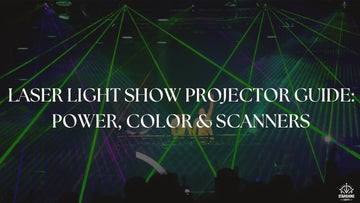
Choosing Order: Work Backward from the Look
2) Throw & frame size — Distance, image size, surface, and haze.
3) Hardware — Prioritize window output, RGB balance, KPPS @ 8°, optical coverage (±°), and IP rating for outdoor.

Three Specs That Decide Results
8°. Trust specs written as 30K/40K/50K/60K @ 8°. Also check optical coverage (e.g., ±60°). Speed and angle must be balanced for clean curves and stable logos on your laser show lights.Mid power (3–12 W) — Medium/large indoor; at night outdoors (6 W+), air beams + basic graphics on laser light projector.
High power (15–40 W+) — Arenas, façades, festivals, long-throw outdoor shows with stage lasers or professional outdoor laser lights.

Modulation & Blanking (Text & Logos)
TTL — 7 fixed colors with jumpy transitions; fine for ultra-basic looks.
• Weddings/ballrooms (text & logos): 3–6 W, 40–50K @ 8°.
• Outdoor mall/plaza: 6–12 W, 40–50K @ 8°, IP65 outdoor laser lights.
• City festival/long-throw beams: 15–30 W+, 50–60K @ 8°, synchronized multi-unit matrix.
• Logo/graphic precision: high-linearity analog + 50K/60K @ 8°, quality optics.

DJ laser lights: 2–6 W analog modulation for smooth text/logo fades; 40–50K @ 8° for clean curves.

Stage laser lights: balanced RGB and 50–60K @ 8° for precise logos/graphics; unify color/scan profiles for multi-unit rigs.

Façade graphics (25–60 m throw) — 12–20 W, 50K @ 8°, IP65. Angle tweaks avoid “wind knife edges.” Speed/angle balance keeps edges clean; less blue improves skin tones and white logos.
Festival beam matrix (multi-unit) — 15–30 W+ with shared color/scan profiles, time sync, split power zones. Consistency + redundancy beat chasing a single extreme wattage.

Buying Checklist (Copy & Use)
| Item | What to Confirm |
|---|---|
| Window output | Measured output at the projection window (in writing), not internal watts |
| RGB balance | Not blue-heavy; wavelengths in spec; looks natural on faces |
| Scanner spec | KPPS listed @ 8° (30K/40K/50K/60K) with optical coverage (±°) |
| Outdoor rating | IP65 enclosure + anti-condensation if long-term outdoor |
| Power safety | RCD/GFCI, drip loops, strain relief, weatherized connectors |
| Logos/text | Analog modulation for smooth fades & clean blanking |
| Commercial terms | Free shipping, 2-year warranty, small-batch orders, OEM/ODM |
What’s the difference between a laser light projector and regular laser lights?
A laser light projector adds scanning hardware and control (KPPS @ angle) for graphics, logos, and precise beam placement, while basic laser lights focus on simple beam effects.
Are DJ laser lights bright enough for small weddings?
Yes. For rooms under 300 people, 2–3 W analog with 40–50K @ 8° delivers clean text and tasteful beams without overpowering the space.
Which outdoor laser lights are best for long-term installs?
IP65 housings with anti-condensation and proper power safety (RCD/GFCI) are built for wet environments. Use drip loops and strain relief on all runs.
How do I size a laser light show projector for a 25–60 m façade?
Most setups look cleaner at 12–20 W with 50K @ 8° than with a slower scanner at higher watts—edges stay sharp and logos read well at distance.
Analog vs TTL—what should I pick for logos?
Analog modulation for smooth fades and clean blanking (0% between strokes). TTL is limited to 7 colors and has jumpier transitions.



























